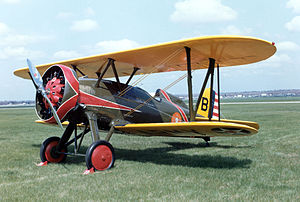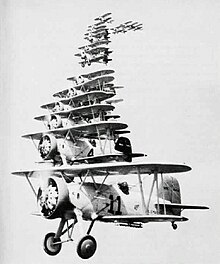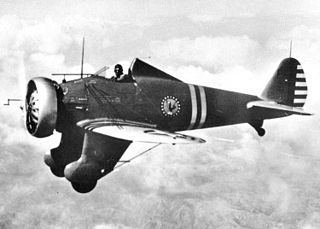
The Boeing P-26 "Peashooter" was the first American production all-metal fighter aircraft and the first pursuit monoplane to enter squadron service with the United States Army Air Corps. Designed and built by Boeing, the prototype first flew in 1932, and the type was still in use with the U.S. Army Air Corps as late as 1941 in the Philippines. There are two surviving Peashooters, but there are three reproductions on display with two more under construction.

The Curtiss Falcon was a family of military biplane aircraft built by the American aircraft manufacturer Curtiss Aeroplane and Motor Company during the 1920s. Most saw service as part of the United States Army Air Corps as observation aircraft with the designations O-1 and O-11, or as the attack aircraft designated the A-3 Falcon.
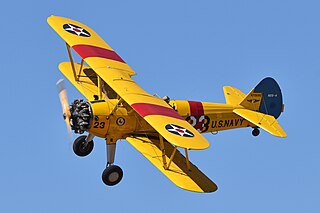
The Stearman (Boeing) Model 75 is an American biplane formerly used as a military trainer aircraft, of which at least 10,626 were built in the United States during the 1930s and 1940s. Stearman Aircraft became a subsidiary of Boeing in 1934. Widely known as the Stearman, Boeing Stearman, or Kaydet, it served as a primary trainer for the United States Army Air Forces, the United States Navy, and with the Royal Canadian Air Force as the Kaydet throughout World War II. After the conflict was over, thousands of surplus aircraft were sold on the civilian market. In the immediate postwar years, they became popular as crop dusters and sports planes, and for aerobatic and wing walking use in air shows.

The Beechcraft Model 17 Staggerwing is an American biplane with an atypical negative wing stagger. It first flew in 1932.

The Curtiss SBC Helldiver was a two-seat scout bomber and dive bomber built by the Curtiss-Wright Corporation. It was the last combat military biplane procured by the United States Navy. Delivered in 1937, it became obsolete even before World War II and was kept well away from combat with Axis fighters.

The Grumman F3F is a biplane fighter aircraft produced by the Grumman aircraft for the United States Navy during the mid-1930s. Designed as an improvement on the F2F, it entered service in 1936 as the last biplane to be delivered to any American military air arm. It was retired from front line squadrons at the end of 1941 before it could serve in World War II, and replaced by the Brewster F2A Buffalo. The F3F, which inherited the Leroy Grumman-designed retractable main landing gear configuration first used on the Grumman FF, served as the basis for a biplane design ultimately developed into the much more successful F4F Wildcat that succeeded the subpar Buffalo.

The Grumman FF "Fifi" was an American biplane fighter aircraft operated by the United States Navy during the 1930s. It was the first carrier aircraft with retractable landing gear. It was produced under licence in Canada and known as the Goblin in Canadian service and Delfín in Spanish service.

The Curtiss P-6 Hawk is an American single-engine biplane fighter introduced into service in the late 1920s with the United States Army Air Corps and operated until the late 1930s prior to the outbreak of World War II.
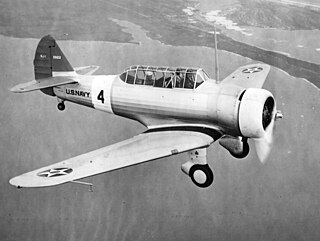
The North American BT-9 was the United States Army Air Corps (USAAC) designation for a low-wing single engine monoplane primary trainer aircraft that served before and during World War II.

The P-1 Hawk was a 1920s open-cockpit biplane fighter aircraft of the United States Army Air Corps. An earlier variant of the same aircraft had been designated PW-8 prior to 1925.

The Boeing YB-9 was the first all-metal monoplane bomber aircraft designed for the United States Army Air Corps. The YB-9 was a much enlarged twin-engine development of Boeing's single-engine Model 200 Monomail commercial transport.

The Airco DH.4 is a British two-seat biplane day bomber of the First World War. It was designed by Geoffrey de Havilland for Airco, and was the first British two-seat light day-bomber capable of defending itself.
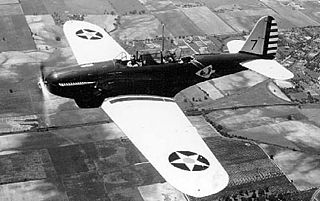
The Consolidated P-30 (PB-2) was a 1930s United States two-seat fighter aircraft. An attack version called the A-11 was also built, along with 2 Y1P-25 prototypes and YP-27, Y1P-28, and XP-33 proposals. The P-30 is significant for being the first fighter in United States Army Air Corps service to have retractable landing gear, an enclosed and heated cockpit for the pilot, and an exhaust-driven turbo-supercharger for altitude operation.

The Boeing Model 15 was a United States single-seat open-cockpit biplane fighter aircraft of the 1920s, manufactured by the Boeing company. The Model 15 saw service with the United States Army Air Service and with the United States Navy as a carrier-based fighter.

The Boeing F2B was a biplane fighter aircraft of the United States Navy in the 1920s, familiar to aviation enthusiasts of the era as the craft of the Three Sea Hawks aerobatic flying team, famous for its tied-together formation flying.

The Boeing F3B was a biplane fighter and fighter bomber that served with the United States Navy from 1928 into the early 1930s.

The Curtiss F6C Hawk was a late 1920s American naval biplane fighter aircraft. It was part of the long line of Curtiss Hawk airplanes built by the Curtiss Aeroplane and Motor Company for the American military.

The Curtiss F7C Seahawk was a carrier-capable biplane fighter aircraft of the United States Navy Marine Corps in the late 1920s and early 1930s.

The Boeing Model 40 was a United States mail plane of the 1920s. It was a single-engined biplane that was widely used for airmail services in the United States in the 1920s and 1930s, especially by airlines that later became part of United Airlines. It became the first aircraft built by the Boeing company to carry passengers.

The Boeing P-29 and XF7B-1 were an attempt to produce a more advanced version of the highly successful P-26. Although slight gains were made in performance, the U.S. Army Air Corps and U.S. Navy did not order the aircraft.
